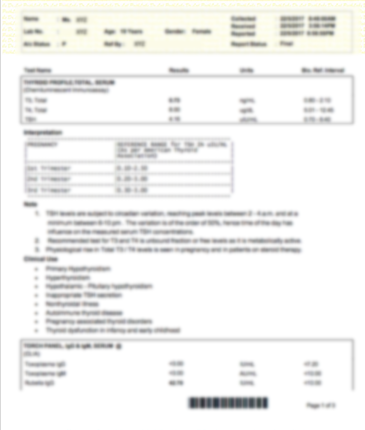Apolipoprotein B (Apo-B)
- C1034
Rs 600
- Why Get Tested?
To detect the presence of anticentromere antibodies; to help diagnose limited cutaneous scleroderma - When To Get Tested?
When you have one or more symptoms that suggest CREST syndrome - Sample Type:SERUM (SST or Plain)
- Fasting :YES (10 to 12 Hours)
- Report Delivery:within 48 Hrs of Test Schdule
- Components:1 Observations
- Also Known As:
Centromere Antibody ACA - Formal Name:
Anticentromere Antibody - Sample Instructions:
A blood sample drawn from a vein in your arm - Test Preparation Needed?
None - What Is Being Tested?
The anticentromere antibody (ACA) is an autoantibody, a protein produced by the immune system that mistakenly targets the body's own tissues. ACA is one of several antinuclear antibodies and targets the centromere, a component of the chromosomes (structures in the nucleus) found in all nucleated cells in our body except red blood cells. The ACA test detects and measures the amount of anticentromere antibody found in blood to help diagnose a form of scleroderma. Scleroderma (also known as systemic sclerosis) is a group of rare connective tissue disorders. There are two distinct subtypes: diffuse cutaneous systemic sclerosis that affects the entire body and limited cutaneous systemic sclerosis. These subsets of systemic sclerosis are defined on the basis of the extent of skin involvement. ACA is found in about 60-80% of people who have limited cutaneous scleroderma; only about 5% of patients with diffuse scleroderma have ACA. Limited cutaneous scleroderma is typically associated with one or more symptoms that are known collectively as CREST syndrome. CREST syndrome symptoms include: Calcinosis – calcium deposits under the skin Raynaud phenomenon – episodes of decreased blood flow to fingers and toes, causing them to turn white and blue Esophageal dysfunction – difficulty swallowing, acid reflux, and heartburn Sclerodactyly – tight, thick, shiny skin on the hands and fingers Telangiectasia – red spots on skin due to swollen capillaries ACA can be present in up to 95% of people who have CREST syndrome. How is the sample collected for testing? A blood sample is obtained by inserting a needle into a vein in the arm. Is any test preparation needed to ensure the quality of the sample? No test preparation is needed. - How Is It Used?
The anticentromere antibody (ACA) test is primarily ordered to help diagnose the autoimmune disorder limited cutaneous scleroderma, a form of systemic scleroderma, and CREST syndrome. The test may be used to distinguish between this and other conditions with similar symptoms. ACA is an autoantibody, a protein produced by the immune system that mistakenly targets the body's own tissues. (For more on this, see the "What is being tested?" section and the article on Scleroderma.) ACA testing may be used to provide a healthcare practitioner with additional information if an ANA (antinuclear antibody) test is positive, especially if the test produces a speckled, nucleolar, or centromere pattern. (For more on this, see the "What does the test result mean?" section in the ANA article.) It may be ordered along with a Scl-70 (anti-topoisomerase) test, usually performed as part of an ENA panel (Extractable Nuclear Antigen antibody panel). Scl-70 is another autoantibody that may be present with scleroderma. An ACA test may be ordered along with other tests for autoantibodies, including ANA. - When Is It Ordered
The ACA test may be ordered when a person has a positive result on an ANA test and one or more of the symptoms associated with CREST. These symptoms include: Calcinosis – calcium deposits under the skin Raynaud phenomenon – episodes of decreased blood flow to fingers and toes, causing them to turn white and blue Esophageal dysfunction – difficulty swallowing, acid reflux, and heartburn Sclerodactyly – tight, thick, shiny skin on the hands and fingers Telangiectasia – red spots on skin due to swollen capillaries - What Does The Test Result Mean?
If a person is positive for ACA and has symptoms of CREST, then it is likely that the person has limited cutaneous scleroderma. ACA is found in about 60-80% of people who have limited cutaneous scleroderma and can be present in up to 95% of those who have CREST syndrome. If someone is negative for ACA, then it is likely that the person's symptoms are due to another condition. However, it is possible, though rare, that the individual has limited cutaneous scleroderma and does not produce anticentromere antibodies. - Is There Anything Else I Should Known?
ACA can be positive in some other autoimmune disorders, such as lupus, rheumatoid arthritis, or primary biliary cirrhosis. Typically, only people who have CREST symptoms are tested for ACA. However, some people may be positive for ACA prior to the development of these symptoms and ACA may be performed in conjunction with testing for other autoimmune disorders. The amount of ACA present does not, in general, correlate to the severity of a person's symptoms.
Frequently Booked Test
Absolute Eosinophil Count
-
C1214
-
5-a-Dihydrotestosterone (5a DHT)
-
within 72 Hrs of Test Schdule
₹ 350.00
Absolute Eosinophil Count
-
C1214
-
5-a-Dihydrotestosterone (5a DHT)
-
within 72 Hrs of Test Schdule
₹ 350.00
Absolute Eosinophil Count
-
C1214
-
5-a-Dihydrotestosterone (5a DHT)
-
within 72 Hrs of Test Schdule
₹ 350.00
